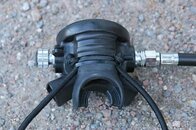Maybe someday I'll have a chance to take you up on that bet!

Absolutely! A win-win...

I am not sure how you have tied your knots, but I believe double fisherman's knots would be the standard way, at least that's how I did it. This allows you to pull the opening for the reg tight. I also have mine cinched very tight, so even if the reg hose was to snag (which would be difficult) the reg would not pull out unless you were scootering, it still comes out with a sharp tug if neccessary, and I cannot see, for the diving I'm doing, changing this setup.
Right, the double fisherman's knot allows the loop that holds the regulator to be adjusted but snug (that is, by pulling the knots apart, you can widen the loop). Mine is a little different, with the knots tied tightly, covered with glued plastic sheaths, that keeps the mouthpiece firmly in place (similar security to the technique of putting a zip tie around the knots):

So if you want to be able to pull the reg from the necklace, the double fisherman's knot works well. If you don't want it to be displaced even with a hard pull (say, if the hose gets snagged on something), then either the zip tie method or the method that I use would be appropriate.
We are certainly in agreement that a bungied necklace is a very good if not preferable way of keeping your regulator, secured and easily accessible, no matter if you dive backmount or sidemount, recreational or tec. In sidemount you do not have a primary and secondary regulator, both regs are "primary" as they are is only 1 2nd stage attached to each 1st stage for each tank.
That makes sense, I know nothing about sidemount, but I can see that you would definitely not want to have either 2nd stage permanently fixed to the necklace in that case.
Why would you donate the regulator from the necklace? Because as a technical diver you are always donating the reg in your mouth (IMHO should be in recreational as well, although it can be taught both ways), and that may be the bungied short hose. You know that the reg is working and delivering gas, and that gas is safe to be breathing at your current depth. Also the ooa diver may be going for the most obvious source of working gas which is the reg in your mouth. Practicing this way (donate the reg in your mouth) also prepares you to have reg out of your mouth for any number of reasons including ooa situations but also maybe some moron just kicked the reg out of your mouth, or you snagged your hose and pulled the reg out, or any other circumstance that you can imagine....
This IS different than backmount doubles (which I assume you are diving), where you are always breathing from your long hose and that is what gets donated, allowing you to go to your bungied backup. In sidemount, if you donate the short hose because that is what you are breathing, you would then switch the reciever to the long hose once both divers have gas and control of the situation.
Yes, absolutely - my previous comments would not apply to sidemount diving.
I am not confusing the OW releasable 2nd, but I think it more comes from your lack of familiarity with sidemount and potential issues that may arrise and how gear needs to be configured differently to deal with those issues. That said, I think the discussion is a good one, as SM becomes more common, you may one day find your self buddied with a SM diver and knowing what may differences you may be dealing with in an emergency can only be a good thing.
A permanently attached bungied backup works for you in BM, and I'm not saying that it will kill you by any streach, but is not the solution for everyone. A releasable solution also will not kill you. I agree as I stated above that there are advantages to even recreational divers learning to donate the reg from their mouth, long hoses, I think need either training or a mentor to show you how not to create more issues mainly around entanglement, but even for recreational diving, in some circumstances can certainly have some advantages.
Absolutely, more learning is always a good thing. But even if I was diving with a SM buddy, that wouldn't change the configuration of my own gear, right?
I didn't mean to imply that you were confused, just that the "permanent vs. quick-release" decision would depend on whether the rescuer was giving the OOG diver her primary or secondary 2nd stage. And with a short primary hose, donating the secondary might be easier. I was just suggesting that she consider the long hose primary donation configuration, which IMHO is better with the backup 2nd stage firmly gripped by the necklace.
Thanks, you too!






